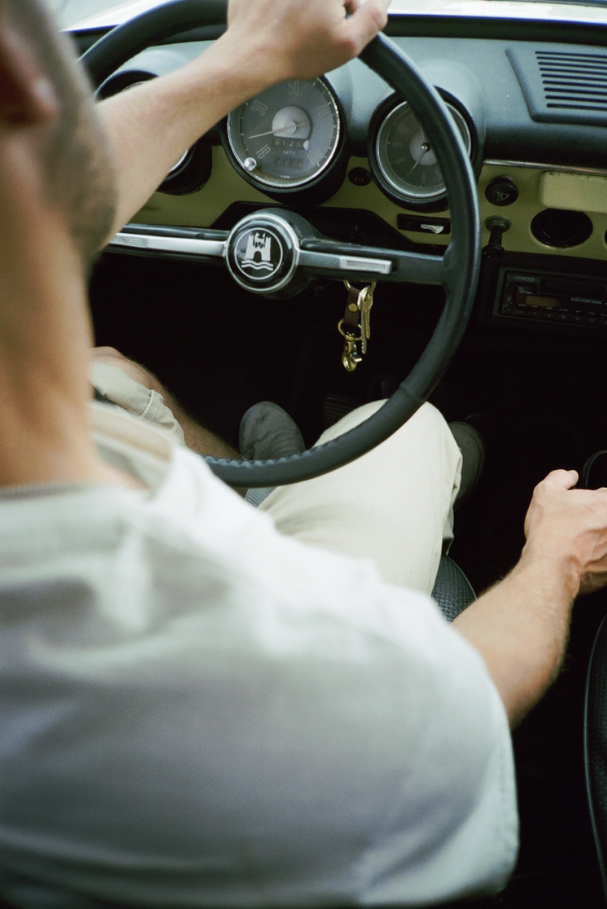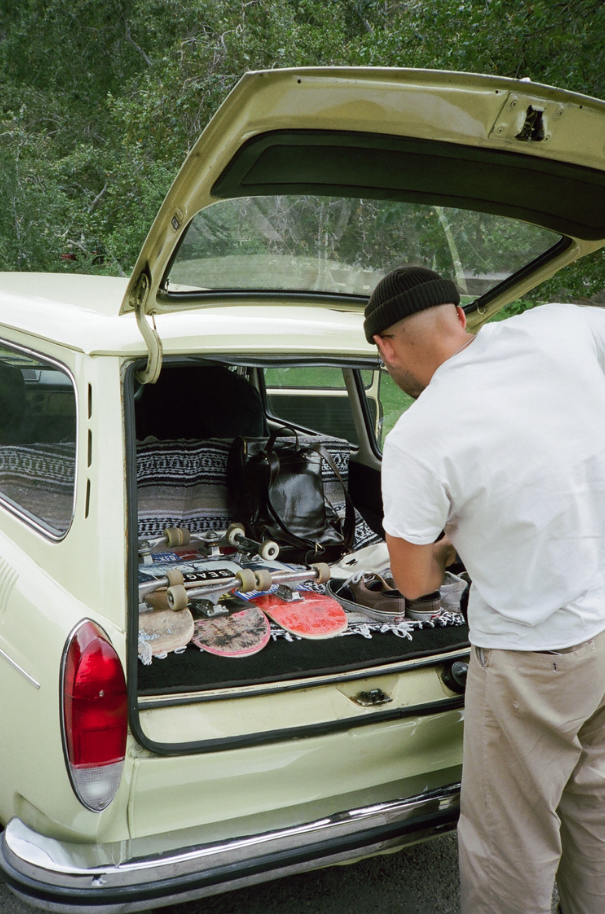Kris Evans has been skateboarding for nine years and shooting photos for the last three. He modestly ascribes some of his success to what he learned from working with widely recognized filmmaker and photographer Nigel Alexander, but in reality it’s his talent and keen ability to translate the spirit and energy of skateboarding on film that has people captivated by his images. Evans is core skateboarding – encapsulating the authenticity that other photographers aspire to – something that can’t be manufactured or recreated.
So far, his short career has included shooting for brands like Element, Seager Co., and Diamond, and documenting people and a culture that are inherently unpredictable. Evans boasts a specific personality to get the most out of skateboarding’s nomadic and fiercely independent lifestyle, becoming a part of the equation, not just ‘the guy with the camera’. The Long Beach-based photographer is well on his way to making a name for himself in the industry – part culled from his teachers and peers, part due to an intuitive skill that fills each frame with a decisive moment and an enticingly warm color scheme. Evans took a second to tell us about how he initially picked up a skateboard and camera, why his favorite photographs come from being on the road, and three photographs he's never forgotten.
How did you first get into skateboarding?
I was 12-years-old and lived in a small town. I lived in a place where racism is still a thing presently, so I wasn’t warmly welcomed onto the football or basketball team. I always wondered if I could be involved in some type of activity that didn’t involve teammates. One day my mom went to Walmart and brought me back this plastic skateboard. I had never stepped on a skateboard before so I fell immediately, and tossed it in my closet. A few days later I went to a park to play catch with some friends and I saw some kids jumping down these stairs on a skateboard. I couldn’t believe they had the guts to fly down these huge stairs on a piece of wood. After that I ran home, got my board, and introduced myself to these kids. They welcomed me with open arms and I was hooked on learning with them.
How did you first get into photography?
I was 18 years old and I originally liked the thought of being a photographer. Having the title of “photographer” is what attracted me and I didn’t take it seriously. I thought just getting a camera would make me seem cool. One day I was skating with a friend around the city, and my mom had let me borrow her film camera. I decided to just start snapping pictures of whatever made me feel good. I think the combination of cruising, having music in my ears, and the sunny afternoon just made me feel this sort of happiness. So whatever I looked at that brought me more joy I would snap a photo of, whether it was a palm tree or people conversing. I even took a photo of this old man sitting on a bench reading with a smile on his face. After I got that first roll developed and saw all of those moments it was the best feeling, and I wanted to share this feeling with the world. From there I wanted to be a photographer not because of the title, but because I was telling a story.
How have skateboarding and photography influenced each other in your life and work? Meaning, what has skateboarding done to the way you see photography and vice versa?
Skateboarding influences my photography in the way that I pay more attention to detail. Skateboarders watch style more than anyone, I believe. How the trick was formed all the way down to whether or not we like the way our arm looked in the shot. The little details help me daily with shooting fashion, landscape and portraits. On the other hand becoming a photographer because I want to tell a story influences my skate photography greatly. I know how to set up my flashes and take the shot of the skater. But when I shoot skateboarding I shoot before the skater does the trick and after. I want to show people the whole process of landing that trick. I shoot him rolling up to the obstacle, him staring it down; there's also moments in-between, like your buddies giving you a high-five before you skate. Those are the moments that I want to capture hoping that it makes the viewer feel like he or she was right there with him. And when I shoot the reactions of him landing the trick and the hugs and smiles he receives, I’m hoping the viewer smiles also.
Where do you generally find your favorite images coming from? Portraits, on the road, skate action scenes, etc.?
My favorite photographs come from being on the road. I love shooting skateboarding, but when you can go and take photos of a place you've never been before its an amazing feeling. You want to explore more and it feels amazing knowing that you have these images forever.
Give me three images you've never forgotten? Tell me who took it and where and when you saw them.
The first image was taken by Arto Saari professional skateboarder and photographer. It was photo of this guy on a mountain, and was in black and white and it had this dark but amazing feeling to it. The second image was taken by surf photographer Morgan Massen. I'm a HUGE fan of his work and it was also a black and white of these two girls on a rock near the ocean and a huge wave splashed right behind them. The third is a photo from a good friend of mine Joe Perri. He took a photo of my friend Noah in Iceland on the side of a mountain with dust behind him so you could only see Noah’s silhouette. All of these photographers are my biggest influence.
What have been the most exciting aspects of working with brands like Element and Diamond? Working with Element and Diamond were short lived but great experiences. Element is a great board company i was able to intern at for a few weeks and learn how the whole skate industry works. The best part is the relationships you build with amazing people. Working with Diamond taught me more than i could’ve imagined. I was able to shoot an event for them under the direction of one of my favorite photographers Seu Trinh who has a ton of respect as a photographer in the skate industry. He showed me how to take my shots of skateboarding to the next level, he also got me connected with some amazing people and ill never forget that.
Favorite project you've worked on lately?
My favorite project so far has been a series called “Home” its a story about my two good friends that have moved from NYC to Long Beach, Calif. I documented the first two weeks here, from the moment they stepped on the new property to one of them (Noah Sahady) kissing the girl he’s been with over long distance for a year now.
How did you start filming and editing with Nigel Alexander?
I met Nigel when I was 19 years old. I knew who he was and introduced myself at a skatepark. I was doing stuff for Element at the time and after a while I would just see him all over the place at random events. One day I DM’d him on Instagram asking if he could use an assistant, and I was just surprised when he responded. He told me to come to his place when I’m ready to start working so the next day I did and we clicked. Nigel is someone I owe a ton to. He introduced me to people that I would’ve never been able to meet on my own and showed me how the entire industry works. He taught me about how lenses really work, also how to use flashes and make skate photos look as professional as possible. He built my reputation since he has such a huge following and eventually i had kids literally asking me for pictures because they knew i was his assistant. Greatest guy on earth and i couldn’t thank him enough.
Why is skateboarding important to you from a creative standpoint?
Skateboarding is important from a creative standpoint because as skateboarding just keeps progressing, so does my level of photography. Skateboarding is getting crazy, guys are jumping down bigger things and skating way harder obstacles to shoot. Keeps me on my toes for sure, looking for new ways to make the skating look as good as possible.
For more from Kris Evans head to his website: http://www.krisryanphoto.com/
Words & Interview: Alex Khatchadourian
Featured portrait: Cody James.








